steering Alfa Romeo 4C 2021 Instructieboek (in Dutch)
[x] Cancel search | Manufacturer: ALFA ROMEO, Model Year: 2021, Model line: 4C, Model: Alfa Romeo 4C 2021Pages: 156, PDF Size: 3.06 MB
Page 27 of 156
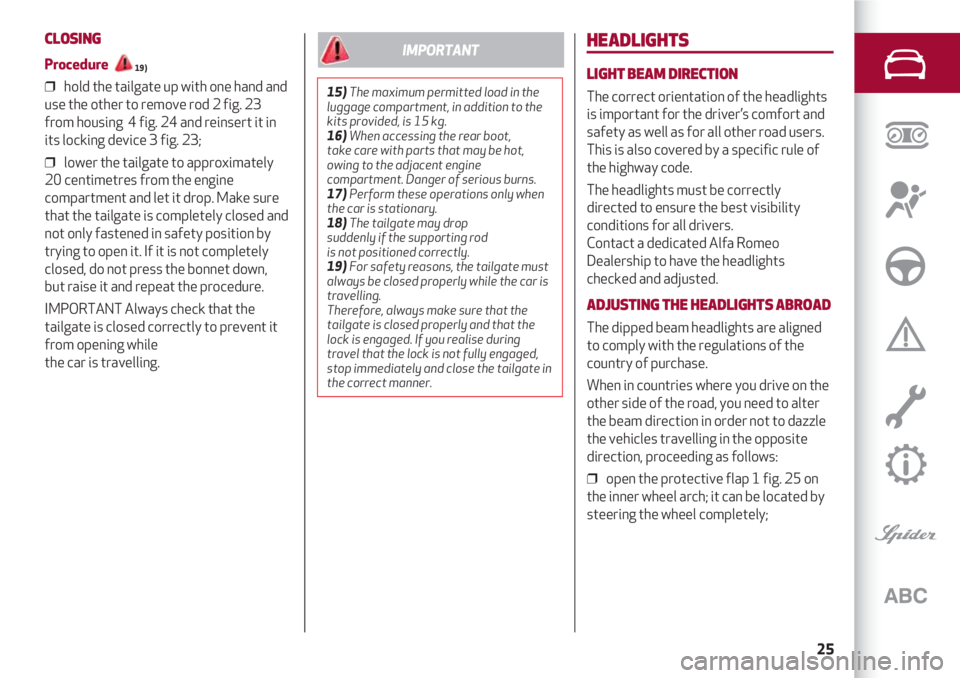
25
CLOSING
Procedure
19)
❒ hold the tailgate up with one hand and
use the other to remove rod 2 fig. 23
from housing 4 fig. 24 and reinsert it in
its locking device 3 fig. 23;
❒ lower the tailgate to approximately
20 centimetres from the engine
compartment and let it drop. Make sure
that the tailgate is completely closed and
not only fastened in safety position by
trying to open it. If it is not completely
closed, do not press the bonnet down,
but raise it and repeat the procedure.
IMPORTANT Always check that the
tailgate is closed correctly to prevent it
from opening while
the car is travelling.
HEADLIGHTS
LIGHT BEAM DIRECTION
The correct orientation of the headlights
is important for the driver’s comfort and
safety as well as for all other road users.
This is also covered by a specific rule of
the highway code.
The headlights must be correctly
directed to ensure the best visibility
conditions for all drivers.
Contact a dedicated Alfa Romeo
Dealership to have the headlights
checked and adjusted.
ADJUSTING THE HEADLIGHTS ABROAD
The dipped beam headlights are aligned
to comply with the regulations of the
country of purchase.
When in countries where you drive on the
other side of the road, you need to alter
the beam direction in order not to dazzle
the vehicles travelling in the opposite
direction, proceeding as follows:
❒ open the protective flap 1 fig. 25 on
the inner wheel arch; it can be located by
steering the wheel completely;
15)The maximum permitted load in the
luggage compartment, in addition to the
kits provided, is 15 kg.
16)When accessing the rear boot,
take care with parts that may be hot,
owing to the adjacent engine
compartment. Danger of serious burns.
17)Perform these operations only when
the car is stationary.
18)The tailgate may drop
suddenly if the supporting rod
is not positioned correctly.
19)For safety reasons, the tailgate must
always be closed properly while the car is
travelling.
Therefore, always make sure that the
tailgate is closed properly and that the
lock is engaged. If you realise during
travel that the lock is not fully engaged,
stop immediately and close the tailgate in
the correct manner.
IMPORTANT
Page 29 of 156
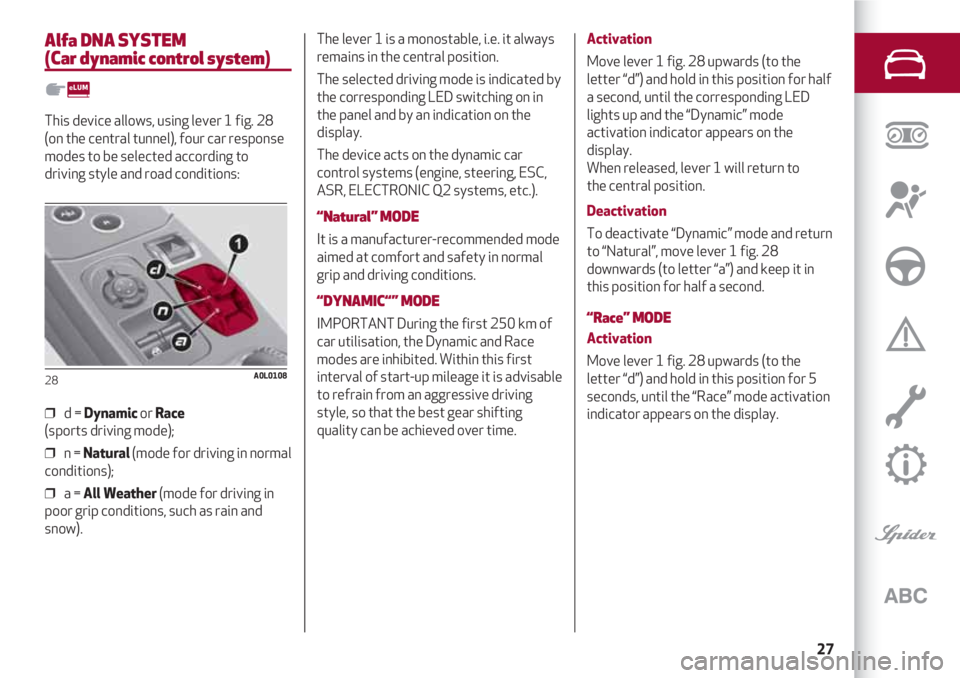
27
Alfa DNA SYSTEM
(Car dynamic control system)
This device allows, using lever 1 fig. 28
(on the central tunnel), four car response
modes to be selected according to
driving style and road conditions:
❒ d = Dynamicor Race
(sports driving mode);
❒ n = Natural(mode for driving in normal
conditions);
❒ a = All Weather(mode for driving in
poor grip conditions, such as rain and
snow).
28A0L0108
The lever 1 is a monostable, i.e. it always
remains in the central position.
The selected driving mode is indicated by
the corresponding LED switching on in
the panel and by an indication on the
display.
The device acts on the dynamic car
control systems (engine, steering, ESC,
ASR, ELECTRONIC Q2 systems, etc.).
“Natural” MODE
It is a manufacturer-recommended mode
aimed at comfort and safety in normal
grip and driving conditions.
“DYNAMIC“” MODE
IMPORTANT During the first 250 km of
car utilisation, the Dynamic and Race
modes are inhibited. Within this first
interval of start-up mileage it is advisable
to refrain from an aggressive driving
style, so that the best gear shifting
quality can be achieved over time.
Activation
Move lever 1 fig. 28 upwards (to the
letter “d”) and hold in this position for half
a second, until the corresponding LED
lights up and the “Dynamic” mode
activation indicator appears on the
display.
When released, lever 1 will return to
the central position.
Deactivation
To deactivate “Dynamic” mode and return
to “Natural”, move lever 1 fig. 28
downwards (to letter “a”) and keep it in
this position for half a second.
“Race” MODE
Activation
Move lever 1 fig. 28 upwards (to the
letter “d”) and hold in this position for 5
seconds, until the “Race” mode activation
indicator appears on the display.
Page 40 of 156
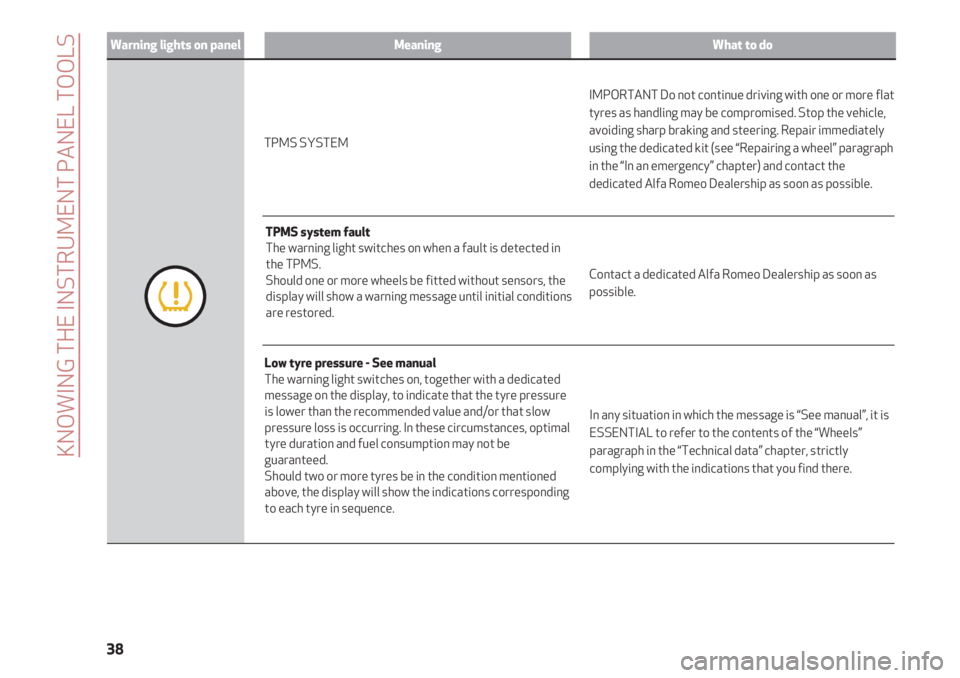
KNOWING THE INSTRUMENT PANEL TOOLS
38
Warning lights on panelMeaningWhat to do
In any situation in which the message is “See manual”, it is
ESSENTIAL to refer to the contents of the “Wheels”
paragraph in the “Technical data” chapter, strictly
complying with the indications that you find there.
Low tyre pressure - See manual
The warning light switches on, together with a dedicated
message on the display, to indicate that the tyre pressure
is lower than the recommended value and/or that slow
pressure loss is occurring. In these circumstances, optimal
tyre duration and fuel consumption may not be
guaranteed.
Should two or more tyres be in the condition mentioned
above, the display will show the indications corresponding
to each tyre in sequence.
Contact a dedicated Alfa Romeo Dealership as soon as
possible. TPMS system fault
The warning light switches on when a fault is detected in
the TPMS.
Should one or more wheels be fitted without sensors, the
display will show a warning message until initial conditions
are restored.IMPORTANT Do not continue driving with one or more flat
tyres as handling may be compromised. Stop the vehicle,
avoiding sharp braking and steering. Repair immediately
using the dedicated kit (see “Repairing a wheel” paragraph
in the “In an emergency” chapter) and contact the
dedicated Alfa Romeo Dealership as soon as possible. TPMS SYSTEM
Page 58 of 156
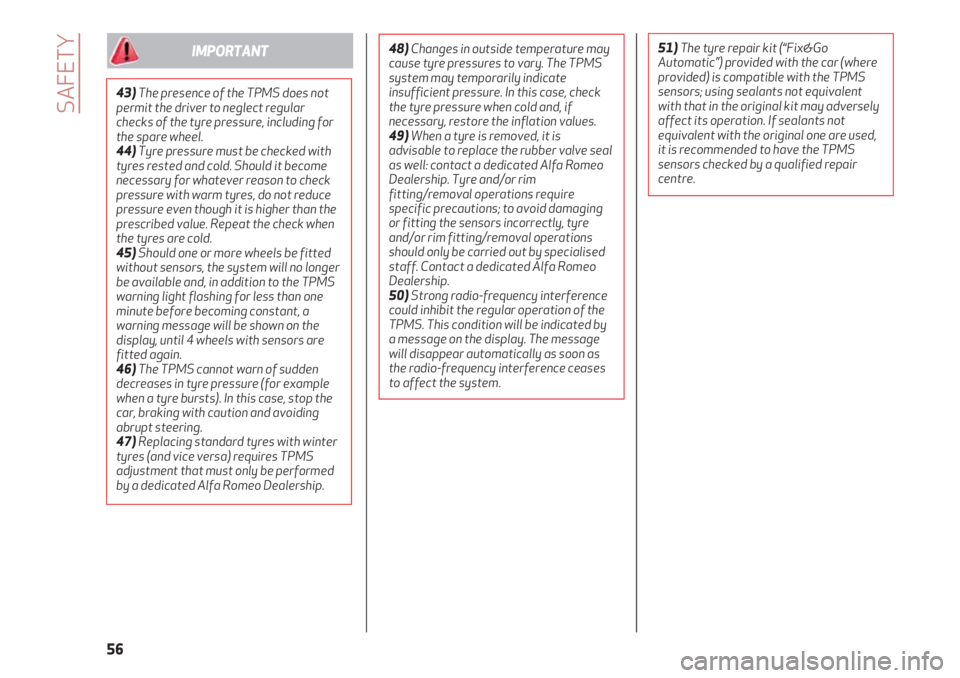
SAFETY
56
43)The presence of the TPMS does not
permit the driver to neglect regular
checks of the tyre pressure, including for
the spare wheel.
44)Tyre pressure must be checked with
tyres rested and cold. Should it become
necessary for whatever reason to check
pressure with warm tyres, do not reduce
pressure even though it is higher than the
prescribed value. Repeat the check when
the tyres are cold.
45)Should one or more wheels be fitted
without sensors, the system will no longer
be available and, in addition to the TPMS
warning light flashing for less than one
minute before becoming constant, a
warning message will be shown on the
display, until 4 wheels with sensors are
fitted again.
46)The TPMS cannot warn of sudden
decreases in tyre pressure (for example
when a tyre bursts). In this case, stop the
car, braking with caution and avoiding
abrupt steering.
47)Replacing standard tyres with winter
tyres (and vice versa) requires TPMS
adjustment that must only be performed
by a dedicated Alfa Romeo Dealership.
IMPORTANT48)Changes in outside temperature may
cause tyre pressures to vary. The TPMS
system may temporarily indicate
insufficient pressure. In this case, check
the tyre pressure when cold and, if
necessary, restore the inflation values.
49)When a tyre is removed, it is
advisable to replace the rubber valve seal
as well: contact a dedicated Alfa Romeo
Dealership. Tyre and/or rim
fitting/removal operations require
specific precautions; to avoid damaging
or fitting the sensors incorrectly, tyre
and/or rim fitting/removal operations
should only be carried out by specialised
staff. Contact a dedicated Alfa Romeo
Dealership.
50)Strong radio-frequency interference
could inhibit the regular operation of the
TPMS. This condition will be indicated by
a message on the display. The message
will disappear automatically as soon as
the radio-frequency interference ceases
to affect the system.51)The tyre repair kit (“Fix&Go
Automatic”) provided with the car (where
provided) is compatible with the TPMS
sensors; using sealants not equivalent
with that in the original kit may adversely
affect its operation. If sealants not
equivalent with the original one are used,
it is recommended to have the TPMS
sensors checked by a qualified repair
centre.
Page 65 of 156
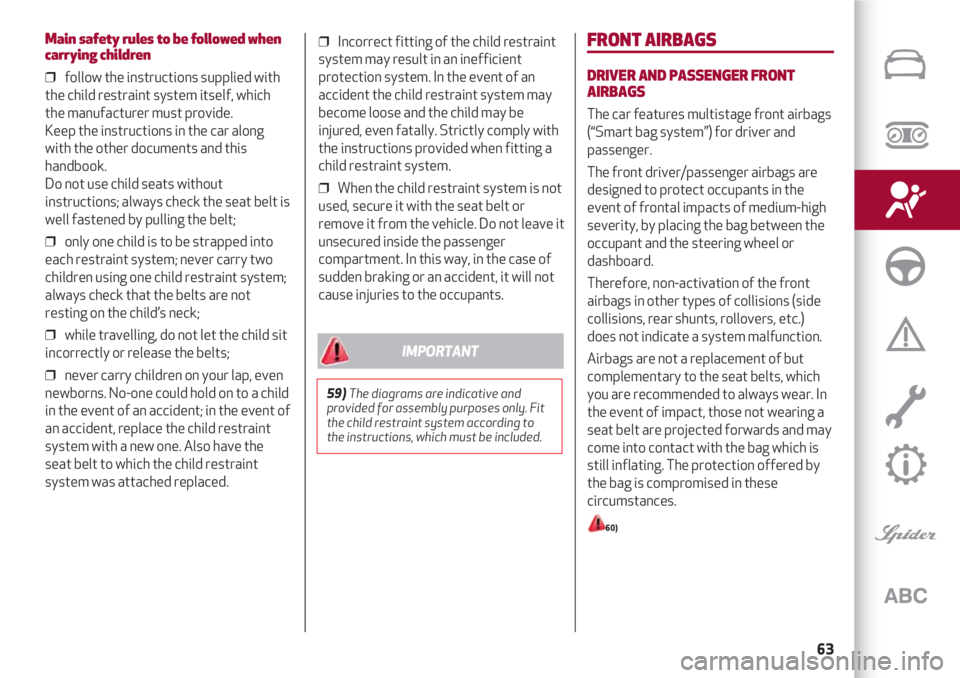
63
Main safety rules to be followed when
carrying children
❒ follow the instructions supplied with
the child restraint system itself, which
the manufacturer must provide.
Keep the instructions in the car along
with the other documents and this
handbook.
Do not use child seats without
instructions; always check the seat belt is
well fastened by pulling the belt;
❒ only one child is to be strapped into
each restraint system; never carry two
children using one child restraint system;
always check that the belts are not
resting on the child’s neck;
❒ while travelling, do not let the child sit
incorrectly or release the belts;
❒ never carry children on your lap, even
newborns. No-one could hold on to a child
in the event of an accident; in the event of
an accident, replace the child restraint
system with a new one. Also have the
seat belt to which the child restraint
system was attached replaced.
FRONT AIRBAGS
DRIVER AND PASSENGER FRONT
AIRBAGS
The car features multistage front airbags
(“Smart bag system”) for driver and
passenger.
The front driver/passenger airbags are
designed to protect occupants in the
event of frontal impacts of medium-high
severity, by placing the bag between the
occupant and the steering wheel or
dashboard.
Therefore, non-activation of the front
airbags in other types of collisions (side
collisions, rear shunts, rollovers, etc.)
does not indicate a system malfunction.
Airbags are not a replacement of but
complementary to the seat belts, which
you are recommended to always wear. In
the event of impact, those not wearing a
seat belt are projected forwards and may
come into contact with the bag which is
still inflating. The protection offered by
the bag is compromised in these
circumstances.
60)
59)The diagrams are indicative and
provided for assembly purposes only. Fit
the child restraint system according to
the instructions, which must be included.
IMPORTANT
❒ Incorrect fitting of the child restraint
system may result in an inefficient
protection system. In the event of an
accident the child restraint system may
become loose and the child may be
injured, even fatally. Strictly comply with
the instructions provided when fitting a
child restraint system.
❒ When the child restraint system is not
used, secure it with the seat belt or
remove it from the vehicle. Do not leave it
unsecured inside the passenger
compartment. In this way, in the case of
sudden braking or an accident, it will not
cause injuries to the occupants.
Page 66 of 156
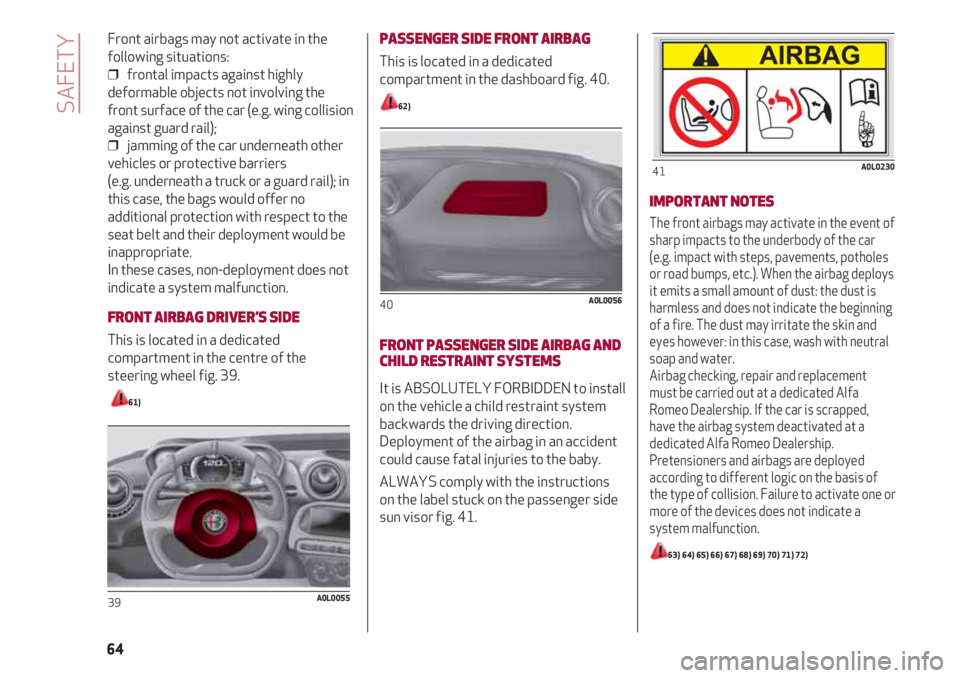
Front airbags may not activate in the
following situations:
❒ frontal impacts against highly
deformable objects not involving the
front surface of the car (e.g. wing collision
against guard rail);
❒ jamming of the car underneath other
vehicles or protective barriers
(e.g. underneath a truck or a guard rail); in
this case, the bags would offer no
additional protection with respect to the
seat belt and their deployment would be
inappropriate.
In these cases, non-deployment does not
indicate a system malfunction.
FRONT AIRBAG DRIVER’S SIDE
This is located in a dedicated
compartment in the centre of the
steering wheel fig. 39.
61)
39A0L0055
PASSENGER SIDE FRONT AIRBAG
This is located in a dedicated
compartment in the dashboard fig. 40.
62)
FRONT PASSENGER SIDE AIRBAG AND
CHILD RESTRAINT SYSTEMS
It is ABSOLUTELY FORBIDDEN to install
on the vehicle a child restraint system
backwards the driving direction.
Deployment of the airbag in an accident
could cause fatal injuries to the baby.
ALWAYS comply with the instructions
on the label stuck on the passenger side
sun visor fig. 41.
40A0L0056
IMPORTANT NOTES
The front airbags may activate in the event of
sharp impacts to the underbody of the car
(e.g. impact with steps, pavements, potholes
or road bumps, etc.). When the airbag deploys
it emits a small amount of dust: the dust is
harmless and does not indicate the beginning
of a fire. The dust may irritate the skin and
eyes however: in this case, wash with neutral
soap and water.
Airbag checking, repair and replacement
must be carried out at a dedicated Alfa
Romeo Dealership. If the car is scrapped,
have the airbag system deactivated at a
dedicated Alfa Romeo Dealership.
Pretensioners and airbags are deployed
according to different logic on the basis of
the type of collision. Failure to activate one or
more of the devices does not indicate a
system malfunction.
63) 64) 65) 66) 67) 68) 69) 70) 71) 72)
SAFETY
64
41A0L0230
Page 68 of 156
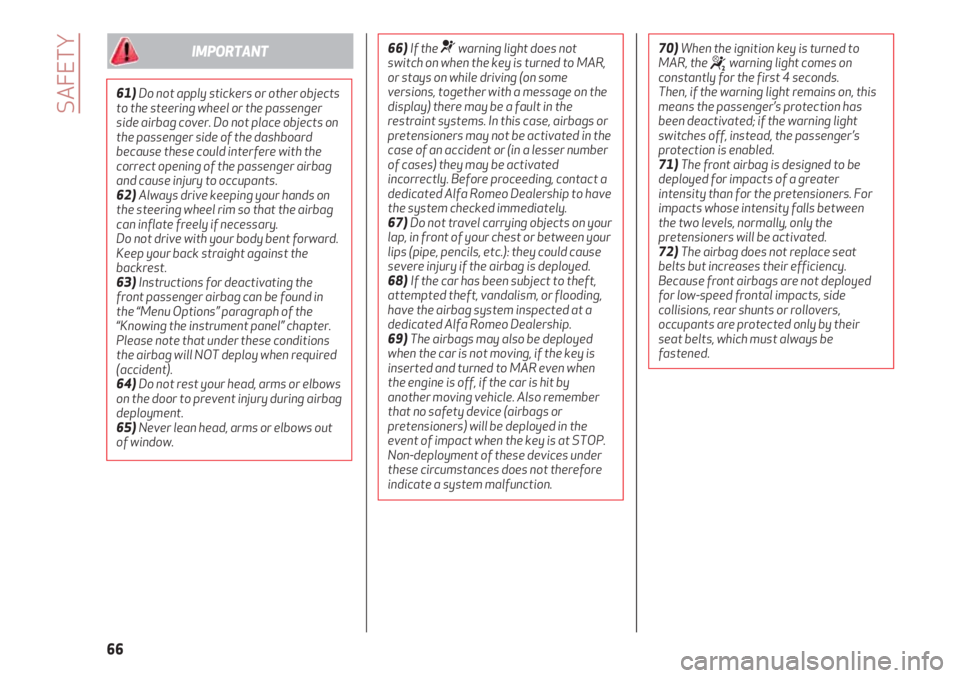
SAFETY
66
61)Do not apply stickers or other objects
to the steering wheel or the passenger
side airbag cover. Do not place objects on
the passenger side of the dashboard
because these could interfere with the
correct opening of the passenger airbag
and cause injury to occupants.
62)Always drive keeping your hands on
the steering wheel rim so that the airbag
can inflate freely if necessary.
Do not drive with your body bent forward.
Keep your back straight against the
backrest.
63)Instructions for deactivating the
front passenger airbag can be found in
the “Menu Options” paragraph of the
“Knowing the instrument panel” chapter.
Please note that under these conditions
the airbag will NOT deploy when required
(accident).
64)Do not rest your head, arms or elbows
on the door to prevent injury during airbag
deployment.
65)Never lean head, arms or elbows out
of window.
IMPORTANT66)If the ¬warning light does not
switch on when the key is turned to MAR,
or stays on while driving (on some
versions, together with a message on the
display) there may be a fault in the
restraint systems. In this case, airbags or
pretensioners may not be activated in the
case of an accident or (in a lesser number
of cases) they may be activated
incorrectly. Before proceeding, contact a
dedicated Alfa Romeo Dealership to have
the system checked immediately.
67)Do not travel carrying objects on your
lap, in front of your chest or between your
lips (pipe, pencils, etc.): they could cause
severe injury if the airbag is deployed.
68) If the car has been subject to theft,
attempted theft, vandalism, or flooding,
have the airbag system inspected at a
dedicated Alfa Romeo Dealership.
69)The airbags may also be deployed
when the car is not moving, if the key is
inserted and turned to MAR even when
the engine is off, if the car is hit by
another moving vehicle. Also remember
that no safety device (airbags or
pretensioners) will be deployed in the
event of impact when the key is at STOP.
Non-deployment of these devices under
these circumstances does not therefore
indicate a system malfunction.70)When the ignition key is turned to
MAR, the
“warning light comes on
constantly for the first 4 seconds.
Then, if the warning light remains on, this
means the passenger’s protection has
been deactivated; if the warning light
switches off, instead, the passenger’s
protection is enabled.
71)The front airbag is designed to be
deployed for impacts of a greater
intensity than for the pretensioners. For
impacts whose intensity falls between
the two levels, normally, only the
pretensioners will be activated.
72)The airbag does not replace seat
belts but increases their efficiency.
Because front airbags are not deployed
for low-speed frontal impacts, side
collisions, rear shunts or rollovers,
occupants are protected only by their
seat belts, which must always be
fastened.
Page 72 of 156
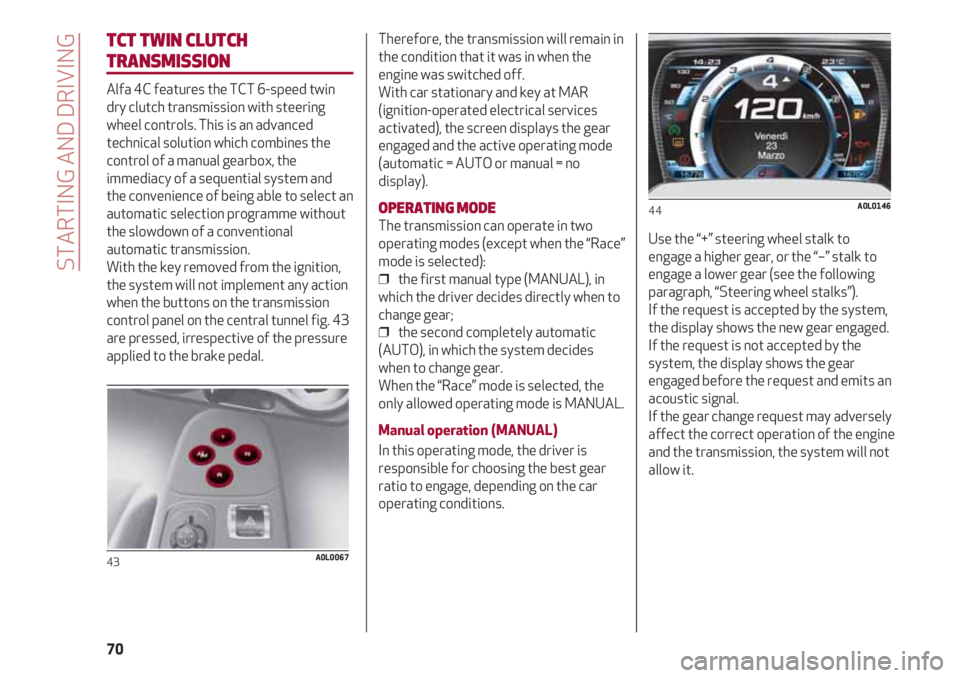
STARTING AND DRIVING
70
TCT TWIN CLUTCH
TRANSMISSION
Alfa 4C features the TCT 6-speed twin
dry clutch transmission with steering
wheel controls. This is an advanced
technical solution which combines the
control of a manual gearbox, the
immediacy of a sequential system and
the convenience of being able to select an
automatic selection programme without
the slowdown of a conventional
automatic transmission.
With the key removed from the ignition,
the system will not implement any action
when the buttons on the transmission
control panel on the central tunnel fig. 43
are pressed, irrespective of the pressure
applied to the brake pedal.
43A0L0067
Therefore, the transmission will remain in
the condition that it was in when the
engine was switched off.
With car stationary and key at MAR
(ignition-operated electrical services
activated), the screen displays the gear
engaged and the active operating mode
(automatic = AUTO or manual = no
display).
OPERATING MODE
The transmission can operate in two
operating modes (except when the “Race”
mode is selected):
❒ the first manual type (MANUAL), in
which the driver decides directly when to
change gear;
❒ the second completely automatic
(AUTO), in which the system decides
when to change gear.
When the “Race” mode is selected, the
only allowed operating mode is MANUAL.
Manual operation (MANUAL)
In this operating mode, the driver is
responsible for choosing the best gear
ratio to engage, depending on the car
operating conditions.Use the “+” steering wheel stalk to
engage a higher gear, or the “–” stalk to
engage a lower gear (see the following
paragraph, “Steering wheel stalks”).
If the request is accepted by the system,
the display shows the new gear engaged.
If the request is not accepted by the
system, the display shows the gear
engaged before the request and emits an
acoustic signal.
If the gear change request may adversely
affect the correct operation of the engine
and the transmission, the system will not
allow it.
44A0L0146
Page 74 of 156
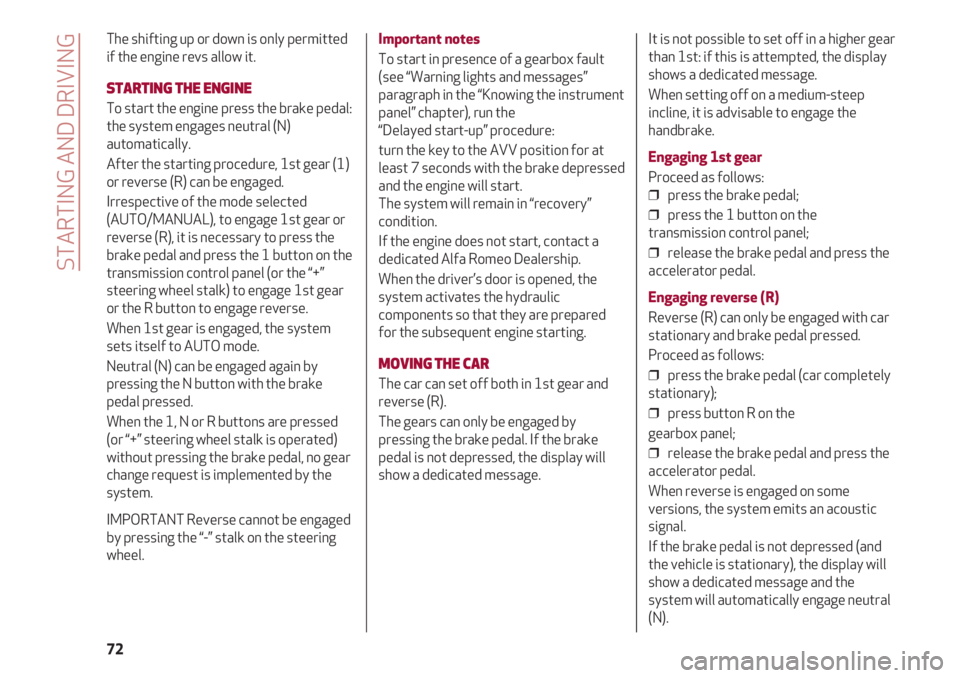
STARTING AND DRIVING
72
The shifting up or down is only permitted
if the engine revs allow it.
STARTING THE ENGINE
To start the engine press the brake pedal:
the system engages neutral (N)
automatically.
After the starting procedure, 1st gear (1)
or reverse (R) can be engaged.
Irrespective of the mode selected
(AUTO/MANUAL), to engage 1st gear or
reverse (R), it is necessary to press the
brake pedal and press the 1 button on the
transmission control panel (or the “+”
steering wheel stalk) to engage 1st gear
or the R button to engage reverse.
When 1st gear is engaged, the system
sets itself to AUTO mode.
Neutral (N) can be engaged again by
pressing the N button with the brake
pedal pressed.
When the 1, N or R buttons are pressed
(or “+” steering wheel stalk is operated)
without pressing the brake pedal, no gear
change request is implemented by the
system.
IMPORTANT Reverse cannot be engaged
by pressing the “-” stalk on the steering
wheel.
Important notes
To start in presence of a gearbox fault
(see “Warning lights and messages”
paragraph in the “Knowing the instrument
panel” chapter), run the
“Delayed start-up” procedure:
turn the key to the AVV position for at
least 7 seconds with the brake depressed
and the engine will start.
The system will remain in “recovery”
condition.
If the engine does not start, contact a
dedicated Alfa Romeo Dealership.
When the driver’s door is opened, the
system activates the hydraulic
components so that they are prepared
for the subsequent engine starting.
MOVING THE CAR
The car can set off both in 1st gear and
reverse (R).
The gears can only be engaged by
pressing the brake pedal. If the brake
pedal is not depressed, the display will
show a dedicated message.It is not possible to set off in a higher gear
than 1st: if this is attempted, the display
shows a dedicated message.
When setting off on a medium-steep
incline, it is advisable to engage the
handbrake.
Engaging 1st gear
Proceed as follows:
❒ press the brake pedal;
❒ press the 1 button on the
transmission control panel;
❒ release the brake pedal and press the
accelerator pedal.
Engaging reverse (R)
Reverse (R) can only be engaged with car
stationary and brake pedal pressed.
Proceed as follows:
❒ press the brake pedal (car completely
stationary);
❒ press button R on the
gearbox panel;
❒ release the brake pedal and press the
accelerator pedal.
When reverse is engaged on some
versions, the system emits an acoustic
signal.
If the brake pedal is not depressed (and
the vehicle is stationary), the display will
show a dedicated message and the
system will automatically engage neutral
(N).
Page 75 of 156
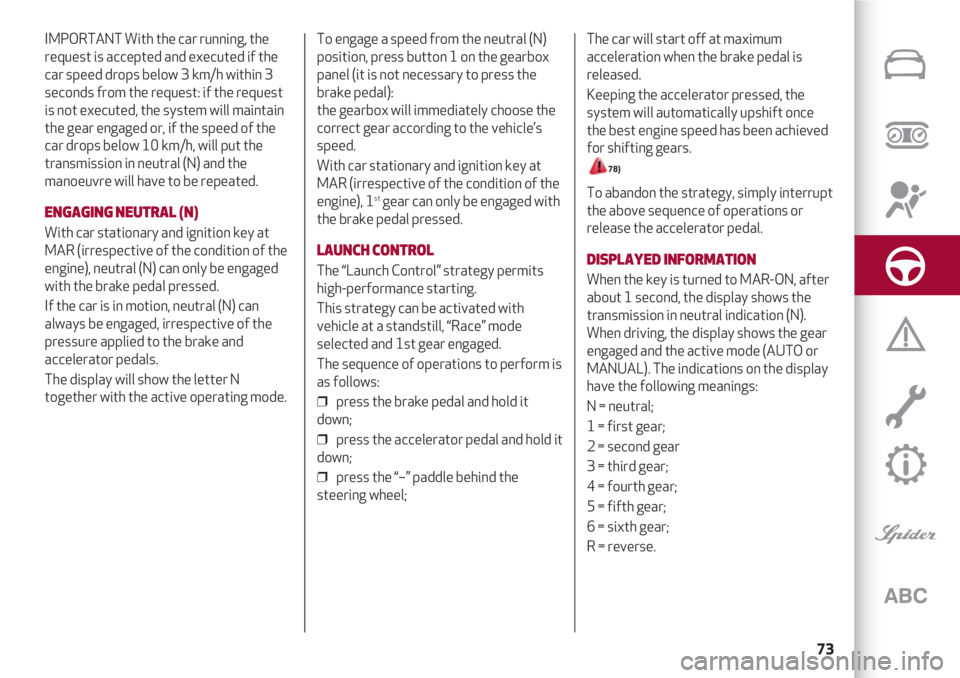
73
IMPORTANT With the car running, the
request is accepted and executed if the
car speed drops below 3 km/h within 3
seconds from the request: if the request
is not executed, the system will maintain
the gear engaged or, if the speed of the
car drops below 10 km/h, will put the
transmission in neutral (N) and the
manoeuvre will have to be repeated.
ENGAGING NEUTRAL (N)
With car stationary and ignition key at
MAR (irrespective of the condition of the
engine), neutral (N) can only be engaged
with the brake pedal pressed.
If the car is in motion, neutral (N) can
always be engaged, irrespective of the
pressure applied to the brake and
accelerator pedals.
The display will show the letter N
together with the active operating mode.To engage a speed from the neutral (N)
position, press button 1 on the gearbox
panel (it is not necessary to press the
brake pedal):
the gearbox will immediately choose the
correct gear according to the vehicle’s
speed.
With car stationary and ignition key at
MAR (irrespective of the condition of the
engine), 1
stgear can only be engaged with
the brake pedal pressed.
LAUNCH CONTROL
The “Launch Control” strategy permits
high-performance starting.
This strategy can be activated with
vehicle at a standstill, “Race” mode
selected and 1st gear engaged.
The sequence of operations to perform is
as follows:
❒ press the brake pedal and hold it
down;
❒ press the accelerator pedal and hold it
down;
❒ press the “–” paddle behind the
steering wheel;The car will start off at maximum
acceleration when the brake pedal is
released.
Keeping the accelerator pressed, the
system will automatically upshift once
the best engine speed has been achieved
for shifting gears.
78)
To abandon the strategy, simply interrupt
the above sequence of operations or
release the accelerator pedal.
DISPLAYED INFORMATION
When the key is turned to MAR-ON, after
about 1 second, the display shows the
transmission in neutral indication (N).
When driving, the display shows the gear
engaged and the active mode (AUTO or
MANUAL). The indications on the display
have the following meanings:
N = neutral;
1 = first gear;
2 = second gear
3 = third gear;
4 = fourth gear;
5 = fifth gear;
6 = sixth gear;
R = reverse.